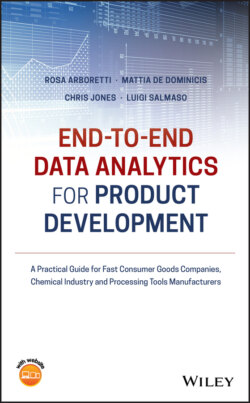Читать книгу End-to-end Data Analytics for Product Development - Chris Jones - Страница 14
Stat Tool 1.1 Statistical Variables and Types of Data
ОглавлениеIn statistical studies, several characteristics are observed or measured to obtain information on a phenomenon of interest. The observed or measured characteristics are called statistical variables. Statistical variables differ according to the type of values they store.
Qualitative or categorical variables can assume values that are qualitative categories and can be either ordinal or nominal.
Quantitative or numeric variables can assume numeric values and can be discrete or continuous. Discrete data (or count data) are numerical values only measurable as integers. Continuous data are numeric values (typically instrumental measures) that can be meaningfully subdivided into fractions.
Example 1.1. For a new shaving oil, it is of interest to compare fragrance A and fragrance B to investigate which is preferred. A sample of female respondents is presented with the two fragrances and asked their age and to answer the following question: How suitable or unsuitable is the fragrance to a shaving aid? Each was asked to assign an integer score from 0 (very unsuitable) to 10 (very suitable). Respondents also expressed their purchase intentions for selecting one of the following categories: Probably would not buy it, Neither, Probably would buy it.The variable “Fragrance” is a nominal categorical variable, assuming two different categories: A and B. The variable “Appropriateness” is a discrete quantitative variable assuming values from 0 to 10. “Age” of the respondents is a continuous quantitative variable, and “purchase intent” is an ordinal categorical variable assuming three different ordered categories.
In some contexts, you may find different terminology used to refer to similar data types. In quality control, categorical and discrete data are referred to as attributes and continuous data as variables.
When performing a statistical analysis, take into account the type of variable(s) you have, i.e. is it qualitative or quantitative? Different graphs, descriptive statistics, and inferential procedures must be used to study different types of data.
